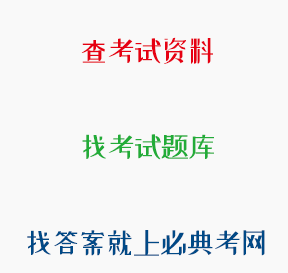正确答案: B
爸爸的思想保守,但不至于触犯法律
题目:12岁的小小是家里的老大,她的爸爸有着严重的重男轻女思想,他不允许小小继续上初中而让她辍学在家帮忙务农,以供家里的弟弟们上学。以下说法错误的是( )。
解析:题干中爸爸的行为违反了《中华人民共和国未成年人保护法》的有关规定。《中华人民共和国未成年人保护法》第十三条规定,"父母或者其他监护人应当尊重未成年人受教育的权利,必须使适龄未成年人依法入学接受并完成义务教育,不得使接受义务教育的未成年人辍学"。故B项中"不至于触犯法律"的说法错误。
查看原题 查看所有试题
学习资料的答案和解析:
[单选题]In ________ the teacher makes use of real situations or sets up a simulation for grammar teaching.A simulation can include the use of material objects, authentic environment, body language, non-verbal means and multimedia materials to make grammar teaching more real and interesting.
situational method
解析:考查教学情境的创设。教师使用真实的情境或者创设模拟情境让学生使用或者练习语法,模拟情境包括对材料的使用、肢体语言、多媒体等。
[单选题]请阅读 Passage 1,完成1~5小题。
Passage 1
In the field of psychology,there has long been a certain haziness surrounding the definition of creativity,an I-know-it-when-I-see-it attitude that has eluded a precise formulation.During our conversation,Mark Beeman,a cognitive neuroscientist at Northwestern University,told me that he used to be reluctant to tell people what his area of study was,for fear of being dismissed or misunderstood.What,for instance,crosses your mind when you think of creativity? Well,we know that someone is creative if he produces new things or has new ideas.And yet,as John Kounios,a psychologist at Drexel University who collaborates frequently with Beeman,points out,that view is wrong,or at least not entirely right."Creativity is the process,not the product," he says.
To illustrate,Beeman offers an example.Imagine someone who has never used or seen a paperclip and is struggling to keep a bunch ofpapers together.Then the person comes up with a new way of bending a stiff wire to hold the papers in place. "That was very creative," Beeman says.On the flip side,if someone works in a new field-Beeman gives the example of nanotechnology-anything that he produces may be considered inherently "creative".But was the act of producing it actually creative? As Beeman put it,"Not all artists are creative.And some accountants are very creative."
Insight,however,has proved less difficult to define and to study.Because it arrives at a specific moment in time,you can isolate it,examine it,and analyze its characteristics."Insight is only one part of creativity," Beeman says."But we can measure it.We have a temporal marker that something just happened in the brain.I'd never say that's all of creativity,but it's a central, identifiable component." When scientists examine insight in the lab.they are looking at what types of attention and thought processes lead to that moment of synthesis: If you are trying to facilitate
a breakthrough,are there methods you can use that help? If you feel stuck on a problem,are there tricks to get you through?
In a recent study,Beeman and Kounios followed people's gazes as they attempted to solve what's called the remote-associates test,in which the subject is given a series of words,like "pine" "crab" and "sauce" and has to think of a single word that can logically be paired with all of them.They wanted to see if the direction of a person's eyes and her rate ofblinking could shed light on her approach and on her likelihood of success.It turned out that if the subject looked directly at a word and focused on it-that is,blinked less frequently,signaling a higher degree of close attention-she was more likely to be thinking in an analytical,convergent fashion,going through possibilities that made sense and systematically discarding those that didn't.If she looked at "pine" say,she might.be thinking of words like "tree" "cone" and "needle" ,then testing each option to see if it fit with the other words.When the subject stopped looking at any specific worD.either by moving her eyes or by blinking,she was more likely to think of broader,more abstract associations.That is a more insight-oriented approach."You need to learn not just to stare but to look outside your focus," Beeman says.(The solution to this remote-associates test: "apple" .)
As it turns out,by simple following someone's eyes and measuring her blinks and fixation times,Beeman's group can predict how someone will likely solve a problem and when she is nearing that solution.That's an important consideration for would-be creative minds: it helps us understand how distinct patterns of attention may contribute to certain kinds ofinsights.
Based on the experiment,which of the following may signal that the subject is nearing the solution?
The subject is distracted from the given words.
解析:推断题。根据原文中的“When the subject stopped looking at any specific word,either by moving her eyes or by blinking,she was more likely to think ofbroader,more abstract associations.”当实验主体通过转动眼睛或眨眼,不再聚焦某一特定词语,她联想的词语可能更抽象,范围也更广。也就是说当实验主体转移注意力,不再聚焦在某一特定词语时,她解决问题的可能性以及何时能得出正确答案可以被预测,即C项正确。B项looks away at something else“看向别处”,与原文表述是不一样的。

 川公网安备 51012202001360号
川公网安备 51012202001360号